Reimar and Walter Horten were two brothers who were born and raised in the Germany of the early 20th century. This was an exciting time for aviation, as almost everything was new, and there was plenty of room for new designs. Being blessed with parents who supported their efforts, to the extent of having the dining room become part of the construction site, Reimar was fascinated by the idea of airplanes which consisted solely of a wing, without the struts, wires, wheels, and various surfaces which dominated the airplanes of the day. The Horten borther were not at all the inventors of the flying wing design which was already used in kites and gliders as early as 1904, but they were absolutely single-minded about it and they never designed and other type of planes than flying wings, called “Nurflügel” in German, which means “wing only.”
The treaty of Versailles forbad Germany to construct aircraft. So, German engineers constructed gliders, and thus the Horten brothers started with gliders, building test models as early as 1929 when they were still young boys. Walter Horten spent the first six months of the war as fighter pilot on the western front, flying a Me 109 in Fighter Squadron No. 26.
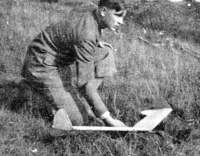
|
Above: Walter Hortentesting a
flying wing model, 1929.
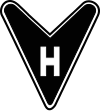
|
Above: The Horten logo.
At this time, Reimar was still in school and Walter in the military; all the construction and testing was done on their spare time and own funding. The tests of the Ho I started in July 1933 at the Bonn-Hangelar airport. It glided from altitudes of 150 to 300 feet. The maximal gliding speed was estimated 228 km/h, and 170 km/h were actually reached. The glider had many stability problems; which the Horten brother tried to fix in-between tests.
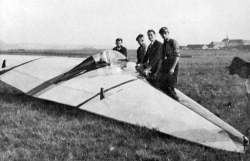 |
Above: The Hortensand some of
their helpers with the Ho I.
In a glider contest where the Ho 1 was confronted to better and more conventional gliders, the Ho 1 earned the Horten brother a “Construction Prize” of DM 600, but no financial support was promised for their next project. A week later the glider school Director ordered Walter to retire from the competition and get rid of the Ho 1. Walter made one last “farewell” flight in the Ho 1, crashed it, then dismantled it, and burned it the following day.
Also built in their home, the Horten brother's second design Ho 2l was ready after nine months. Three “l” subtypes were then constructed at Lippstadt, Germany, in 1937, and taken to the Bonn-Hangelar airport in May 1935. The pilot was in a reclining position, transparent panels were supposed to ensure visibility but they did poorly. Stability was much better than with Ho 1, although not all problems were solved.
The brothers were able to borrow a 60 HP Hirth engine, and after a three month long modification program, they were able to take off an Ho 2m on their own. They had calculated that only 20 HP was needed for takeoff; the excess power of the Hirth engine allowed it to accelerate to 180 km by the time it reached the far end of the runway. The Ho II would climb to 3000 feet in two and a half minute.
The world famous German test pilot Hanna Reitsch flew it near Berlin in November 1938, and wrote a quite negative report:
| Comfort: | Mediocre. |
|---|---|
| Visibility: | Poor. |
| Entry/exit: | Athletes only. |
| Instrument panel: | Fair. |
| Gear operation: | Only possible for long armed pilot's. |
| Steering friction: | Unacceptable. |
| Takeoff: | Stick all the way back to break ground. |
| Landing: | Simple, with good glide path control. |
| Stability: | Difficult to assess, since the stick remains where it is put due to friction. |
| Pitch response: | Normal. |
| Roll control: | Unfriendly, some flutter in turbulence. |
Larger pictures of Ho II here.
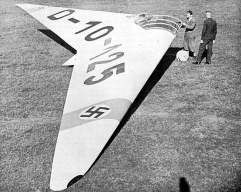
|
Above: Horten Ho 2.
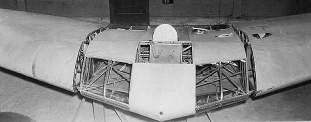
|
Above: Horten Ho 2 in NASM museum, California.
The pilot stretched flat on his stomach, bent slightly at the waist and knees, feet resting on rudder pedals hinged above his heels. A padded chin rest supported his head which projected into the leading edge of the wing. Clear plastic panels formed the leading edge for several feet above, below, and to either side of the pilot. Visibility was good and drag greatly reduced. However, neither view nor pilot comfort in the H IIIf approached the outstanding qualities of the semi-prone layout Reimar Horten developed for the Ho IV and Ho VI sailplanes.
One pilot was killed and another wounded when several Ho III and other gliders in a competition on August 6, 1938 were swallowed in a thunderstorm. Four Horten Ho 3 appeared at the Wasserkuppe in 1939, where Scheidhauer made Gold-C distance, by flying over 200 miles.
With the blessing of the Air Ministry, ten Ho 3b were constructed in Bonn, some would be converted to a “d” model, with the installation of a Walter Micron engine and conventional pilot position. Lastly a Horten IIIf and a possibly two seater IIIg were built in 1944 at Goettingen.
Pilot Josef Eggert flew the Ho IIIg twenty times during September 1944, amassing 14 hours and 17 minutes of total flight time. Eggert reported excellent handling qualities but he apparently preferred not to grapple with adverse yaw. Horten test pilot, Heinz Schiedhauer, and another experienced glider pilot, Hermann Strebel, conducted test flights of models equipped with various additional test equipment.
The fuselage and other parts of a Ho 3 are visible at the Simthsonian Institute in the US.
Larger pictures of Ho III here.
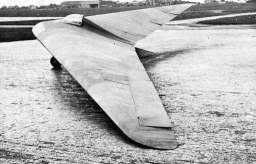
|
Above: Horten Ho III version b.
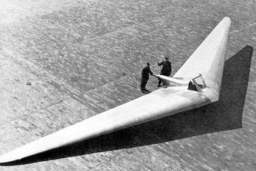
|
Above: Horten Ho III version e.
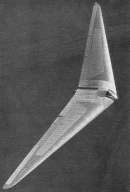
|
Above: Horten Ho III version f.
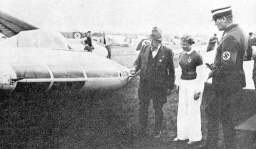
|
Above: Horten Ho III at an air show, presented to the very popular German test pilot Hannah Reitsch.
Above: Horten Ho III rudder from the Smithsonian institute. Notice the specifications: plane weighs 298 kg and can carry 180 kg.
After the invasion of the U-K was canceled, Reimar Horten had the opportunity to start on the next project, the Ho IV. Work was started with no official approval in December 1940 at the glider pilot school in Braunschweig, until the school was moved to Koenigsberg in December 1941. The building of the Ho IV continued in Koenigsberg, and the aircraft was completed in just eight months.
The first Ho IV flew in May 1941. After a few low level winch tows, Horten's test pilot Scheidhauer took an aerotow to 10.000 feet and returned after more than one hour in the air. Without official approval, the flight tests continued quietly, with up to 50 flying hours per month.
A reconstructed Ho IV was even flown by Dezso George-Falvy during tests at Mississippi State University in the US in 1959. A Ho IV is also currently at the Planes of Fame Museum in Chino, California, where restoration work is continuing.
Larger pictures of Ho IV here.
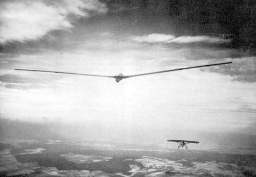
|
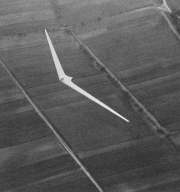
|
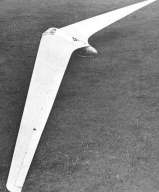
|
Above: Horten Ho IV.
The Ho V was actually the world's first plane built of composite material: a close relationship with the chemical company Dynamit AG in Troisdorf had developed during the construction of the Ho 2, and “Mipolan” and “Astralon” material were made available for various curved parts, which worked out so well that it appeared the time had come to try to build an entire aircraft from these new materials. A weight saving of 15% was realized, with no loss in strength.
The Ho 5 had been parked in the open since the start of the war, and was deteriorating fast. The Horten brothers finally managed to get permission to have it repaired in August of 1941: the Air Ministry became interested in an aircraft concept in which there was full rear view. The tests were unfortunately interrupted when an engine failed during takeoff and a wing tip touched the ground, causing a total loss of the aircraft.
Larger pictures and more pictures of Ho V here.
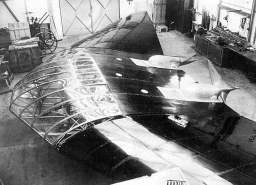
|
Above: Horten Ho 5.
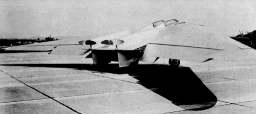
|
Above: Horten Ho 5b.
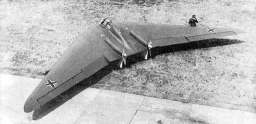
|
Above: Horten Ho 5c.
Reimar Horten designed this concept with the claim that the “parabola” shape is theoretically the most efficient and has the minimum induced drag, so he decided to build an entirely parabolic glider. He got actually this idea from a flying seed, Zanonia Macrocarpia, which is found in Southeast Asia. When mature, the seed drops from the vine and glides to a new location to reproduce itself. The seed was well known by flying win engineers and has already inspired kites and gliders as early as 1904.
The Horten parabola had no motorization, and was designed only for high altitude flights. Because of the curved shape, it was very difficult to construct it, so only one prototype was finished, The aircraft warped severely during winter storage, and was burned and scrapped without ever being flown.
This did not bother some speculators that do not think that UFOs can be of extraterrestrial origin: they claimed that the Horten Parabola is the explanation for the famous observation by Kenneth Arnold in 1947, simply because a drawing made from Arnold's description of the aircraft he saw included that they had a parabolic shape. The fact that the only exemplary of the wooden non-motorized Horten Parabola glider never flew and was long scrapped did not bother them much.
Larger pictures of the Horten Parabola here.
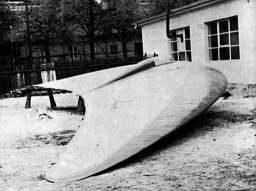
|
Above: Horten “Parabola.”
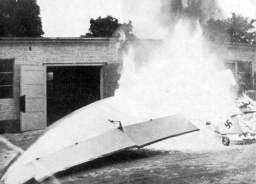
|
Above: Horten “Parabola” on fire.
Two Horten VI gliders were built by Reimar Horten in 1944. He clearly intended a high aspect ratio glider with ultra-high performance to succeed to the Horten IV. The Horten VI V1 flew once and survived war's end but advancing Allied ground forces destroyed it. The second prototype never flew. It is now in the NASM collection.
Larger picture of the Horten VI here.
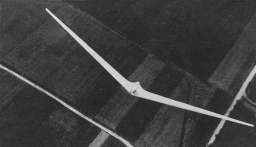
|
Above: Horten Ho VI.
The Luftwaffe wanted a test aircraft for their new Schmitt-Argus pulse jet engine, and inquired about using the Ho V. As the thrust of the engine was in excess of what the aircraft could handle, a new, heavier aircraft with similar features was proposed. This would be the Ho VII, a fully acrobatic two seater, with provisions for the jet engine between its two pusher propellers. The fuselage was in dural and the wings in wood.
The Ho VII would also be an excellent training aircraft. One prototype was ordered from the Peschke factory in Minden.
The Ho VII with Luftwaffe designation 8-254, was soon completed, but did not receive the pulse jet as planned, and remained a training aircraft. The Peschke plant needed additional work, and soon six Ho III's were in production. Using parts from surplus Ho III b's, one model “e” with VW engine, three “f”s with prone pilot accommodation and two “g” two seaters were completed.
The first flight was in 1944, the aircraft was then demonstrated before Reichsmarshal Goering in an attempt to quell the official distrust of flying wings.
Larger picture and additional picture of the Horten VI here.
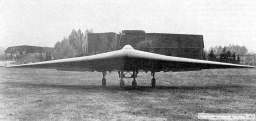
|
Above: Horten Ho 7.
Reimar Horten says in his biography:
Our next project was a large aircraft with 120 feet span and six engines. This Ho VIII would have two fuselage pod configurations one for cargo, the other build as a flying wind tunnel. Unfortunately, no contract was received to build it.
However, the construction progressed quickly through the spring of 1945, and the aircraft was half finished when the American forces reached Goettingen.
In February 1945 a committee under Professor Bock with representatives from Junkers, Messerschmitt and Horten, deliberated over the optimum design for a 4-jet-engined bomber. Designs by Junkers (Ju 287. A swept forward tailed aircraft), Messerschmitt (Project 1107 as swept back tailed aircraft), and Horten (swept back tailless) were considered, and a joint report issued giving the committee's opinion on the best estimate for relative performance. Junkers published the report.
The specification to be noted was for 900 km/h at 10 km height and a range of 3,000 km using four H 11 jets. According to Horten the committee decided that his machine, given the same top speed as the others would have more range and less landing speed. (125 km/h against the 175 km/h for the others.) Alternatively he could carry 8 tons of bombs against the 4 by his competitors for the same range.
The dimensions of the aircraft were roughly as follows:
| Ju and Me: | Horten VIII: | |
|---|---|---|
Span: |
17-18 m | 30 m |
Aspect Ratio: |
5.5 | 5.5 |
Wing pressure: |
500-600 kg/sq.in. | 220 kg/sq.in. |
All the above figures were remembered by Reimar Horten, who used them as a rough illustration. They are not necessarily accurate.
In the structural design Reimar Horten reckoned to save 6% of the all up weight (spar and rib weight) compared with the conventional type. He thought the committee a bit unfair because they insisted on increasing his estimate of structure weight by about a ton.
The Horten Ho IX was an experimental jet fighter-bomber. It was intended to use the same Junker 004 engine that would successfully equip the Messerchmitt Me 262. Development of the operational combat version was assigned to the Gotha company, where it was known by the designation Go-229.
A first prototype had no motorization, it was intended as glider for stability tests. The second aircraft, scheduled to fly three months later, was awaiting its engines, promised in March 1945. Reimar Horten says in his biography:
In March 1943, the performance curves and installation drawings for the Junkers 004 jet engine came into our hands. Walter had seen the Me 262, and obtained data that had previously been kept secret. Work on the Ho VII was put aside, as we eagerly sought to submit a proposal for the 1000-1000-1000 jet that Reichsmarshal Goering had requested. Our proposal was accepted, and the Reichsmarshal ordered the first Ho IX (8-229) to be flown within six months.
The Ho IX contract generated a flurry of activity that none of our workshops could handle alone. Thus, the work was spread out, and efficiency suffered. For flight tests, a Ho III was modified with 60 sweep back to become the Ho XIII a, and two high aspect ratio Ho Vl's were built in Aegidienberg for “middle-effect” testing.
“Despite the hardships, the Ho IX V-1 flew in March 1 as a glider, precise on schedule. The jet powered V-2 was scheduled to fly three months later. Several weeks passed, and then... Disaster! The engines arrived with an accessory section added to the case, making the cross section oval, and the diameter 20 cm greater! No one had bothered to inform us! Now, just six weeks before the first flight, we were faced with the problem of fitting an 80 cm engine into an aircraft with a 60 cm hole in the spar! It meant that the wing would have to be made thicker.”
On the more conventional Me 262, this would not have been a problem, as the jet engines were attached under the wing. But for the Horten IX where the jet engines were to be integrated in the wing, it meant that the whole plane had to be redesigned.
“After the first successful flight of the Ho IX V-2, the Ho VIII project was approved, and the aircraft was half finished when the war ended. The production contract for the Ho IX was awarded to the Gothaer Waggonfabrik.”
Test pilot Erwin Ziller's flight log book mentions a first flight with the two jet engines on February 2, 1945, whereas Reimar Horten claims the first flight occurred on December 18, 1944.
This was of course to late. On April 14, 1945, the US Army arrived at the production plant and seized the Go 229. The half finished first production Horten 9 aka Gotha Go 229 is now stored at the Planes of Fame Museum in Chino, California.
Another interesting item is that this series of Horten flying wings were constructed mainly with wood, covered with a special fabric, and the combination of this construction and the flying wing design itself had the consequence that the plane had been barely detectable on radar. Several decades before the US F-117 and B2, the Hortens did actually almost put a flying wing stealth jet fighter-bomber in production.
A drawing of the Ho 9 is often shown: it is the cover from the model kit made by Dragon Models Limited (DML) [1/48 Master Series: Kit#5505 Ho229A-1 Flying Wing]. Revell also sells a 1/72 model kit of Ho IX.
Larger picture and additional picture of the Horten IX here.
Color pictures of the Ho IX at NASM museum.

|
Above: Horten Ho 9 before a test flight.
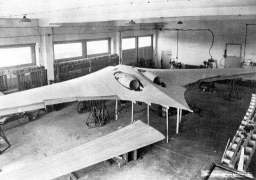
|
Above: Horten Ho 9. The jet engines visible in this photographs were not actual jet engines but dummies used as placeholders.
The Ho X was a high speed arrow shaped flying wing inspired by Busemann's statement in 1936 of the beneficial effect of sweepback on delay of the shock stall. This apparently cheered up the Horten brothers and gave them new proof that they were working on the right lines. They took some inspiration from similar concepts by Lippish also.
Initial work on the H X consisted of experiments with flying models of 10 feet length weighing about 8-10 kg. From these they deduced the CG position needed for satisfactory flight with low aspect ratio and high sweepback, and found that they got good results with 4° dihedral and no fin area. The next step was man carrying glider model weighing 400 kg.
Work on the glider Ho X was in progress at Hersfeld. But on June 4, 1945 the location were found to be used as an M.T. servicing depot and all aircraft components had been dumped in a basement. Only one wing rib and the main spar could be found. All drawings and calculations had gone.
The next step was to have been a power version with an Argus AS 10C pusher engine. The final development was envisioned as a jet propelled aircraft, with the same general dimensions, weighing 6-7,000 kg. A single H 11 jet engine was proposed and a supersonic top speed of 1,200 km/h was expected with 1,300 kg thrust; the thrust was to be improved to 1,500 kg.
The propelled Ho X existed only as a plastic model kit for kids, ref. SHARKIT 72007.
Larger pictures and additional picture of the Horten X model kit here.
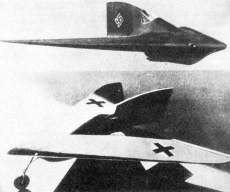
|
Left: Horten Ho 10 model.
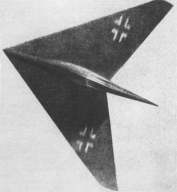
|
Left: Horten Ho 10 model.
The Horten Ho XI was an acrobatic glider of 8 meters span. It was built at Hersfeld and had no features of special interest.
Larger picture of the Horten XI here.
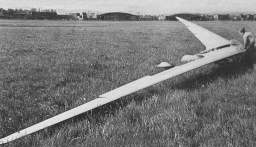
|
Above: Horten Ho 11.
The Ho 12 was a light side by side two seater with a 100 hp engine. It was intended as a private owners coupe but R.L.M. were interested in it as a trainer. The first of the type was built and flown at Goettingen, where it was found destroyed in June 145, as a glider; work was also in progress at Kirtorf where a mock up of the power center section was found, badly damaged by fire.
General dimensions were as follows:
Span: |
10 m |
|---|---|
Aspect Ratio: |
8 |
Wing Area: |
32 sp./m (345 sp.ft.) |
Leading Edge Sweepback: |
30° |
Weight: |
700 kg (1,550 lb.) |
Wing Loading: |
2.19 kg/sq.in. (4.5 lb/sq.ft.) |
Little flying had been done, but it was found that the same troubles were arising as on the Ho 4b. The laminar flow sections were causing bad tip stalling and loss of control effectiveness at the stall.
Ho XIII was a glider to test the swept-back wing concept for the Ho X, but the war ended before Ho X was constructed.
Larger picture of the Horten XIII here.
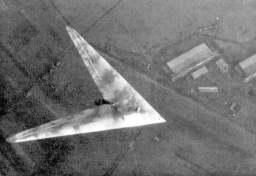
|
Above: Horten Ho 13a.
This was a sports sailplane designed to conform to the 1939 Olympic Games specification. It was designed for simplicity and ease of production. The first aircraft was built from sketches and proper drawings for the production type were made later with slight modifications. Construction was carried out at Hersfeld.
Performance was stated to be:
Maximum Gliding Ratio: |
1:30 at 70 km/h |
|---|---|
Minimum Sinking Speed: |
0.62 m/sec at 55 km/h |
Alfons Putzer remembers:
“As Goettingen fell to the advancing American troops, the Horten brothers, myself and a couple of staff members drove to Brandis near Leipzig with a trailer, containing the almost finished Ho XIV. The staff at the Me 163 base there, under the command of Wolfgang Spate, was cooperative, and gave us access to a workshop. As soon as our work got underway, both the Americans and the Russians were practically on our doorstep. The Hortens hurried off to Berlin, while I was asked to try to save the H XIV. The three of us remaining put the sailplane back in the trailer again, then managed to commandeer a Mercedes diesel truck, loaded it up with extra fuel cans, hooked up the trailer and headed West.”
The Ho XVIII was basically shaped like the Ho 8, with aerodynamic refinements for a Mach speed of 0.75, 6 jet engines, and was intended to be used as a bomber with a 4000 miles operating range, which indicates and intent to bomb America. The idea behind it was probably to carry an atomic bomb to New York or Washington, but luckily for the allies, the bomb was still only theoretical, the engines probably could not have lasted the journey, and the plane could not possibly have been completed before Germany surrendered.
Reimar Horten says in his biography:
“Our final contract; to develop a six jet long range bomber, was received on March 12, 1945.”
“To gain some experience with large flying wings, I had proposed to double the size of a Ho III, equip it with six 640 HP pusher engines, give it an endurance of 20 hours at 500 km/h, and the ability to carry a few bombs. Such an aircraft would be useful in the North Atlantic war. The official argument against it was that “our bombers already do 500 km/h!”
“The order to proceed with the building of the Ho XVIII came, despite my arguments that preliminary calculations were not completed. Construction was started in Kahla near Weimar in April 1945.”
Much too late again. Construction was never finished.
Larger drawing of the Horten XIII here.
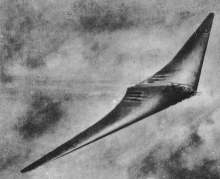
|
Above: Horten Ho 18, illustration.
Russell Lee of the Smithsonian institute tracked the recovery and shipment to the US of a significant number of Horten planes. He summarized:
They were insignificant to the German war effort, yet the Army Air Forces troubled themselves to acquire not one but four examples. Difficulties with the B-35 [Northrop Flying Wing] might have spurred interest in studying Reimar Horten's successful designs. The Air Force soon lost interest and the gliders fell on hard times. Yet they survived and now enjoy the attentions of a restoration team dedicated to preserving them. This is fortunate indeed for without doubt these fascinating artifacts have many more tales to tell.
Here is the Air Intelligence report of investigations conducted to determine if the Horten brothers flying wings could be the source of flying saucers:
SECRET
16 December 47
Subject: Horton [sic] Brothers (Flying Saucers)
To: Deputy Director of Intelligence
European Command, Frankfurt
APO 757, US Army
1. The Horten brothers, Reimer and Walter, are residing in Goettingen at present. However, both of them are travelling a great deal throughout the Bi-Zone. Walter at present is travelling in Bavaria in search of a suitable place of employment. It is believed that he may have contacted USAFE Headquarters in Wiesbaden for possible evacuation to the United States under “Paper Clip”. Reimar is presently studying advanced mathematics at the university of Bonn, and is about to obtain his doctor's degree. It is believed that when his studies are completed he intends to accept a teaching position at the Institute for Technology (Technische Hochschule) in Braunshweig sometime in February or March 1948.
2. Both brothers are exceedingly peculiar and can be easily classified as eccentric and individualistic. Especially is this so of Reimer. He is the one who developed the theory of the flying wing and subsequently of all the models and aircrafts built by the brothers. Walter, on the other hand is the engineer who tried to put into practice the several somewhat fantastic ideas of his brother. The clash of personalities resulted in a continuous quarrel and friction between the two brothers. Reimer was always developing new ideas which would increase the speed of the aircraft or improve its maneuverability; Walter on the other hand was tearing down the fantastic ideas of his brother by practical calculations and considerations.
3. The two men worked together up to and including the “Horten VIII” a flying wing intended to be a fighter plane powered with two Hirt engines (HM-60-R) with a performance of approximately 650 horsepower each. After the “Horten VIII” was finished, one of the usual and frequent quarrels separated the two brothers temporarily. Walter went to work alone on the “Horten IX”, which is a fighter plane of the flying wing design, with practically no changes from the model VIII except for the engines. Walter substituted the Hirt engines with BMW Jets of the type TL-004. The plane was made completely of plywood and was furnished with a Messerschmitt ME-109 landing gear.
The model of this aircraft (Horten IX) was tested extensively in the supersonic wind tunnel (Mach No. 1.0) of the aero-dynamic testing institute (Aerodynamische Versuchsanstalt), located in Goettingen. The tests were conducted in the late summer of 1944 under the personal supervision of Professor Betz, chief of the institute. Betz at that time was approximately sixty years old and next to Prandtel (then seventy-eight years old), was considered to be the best man on aerodynamics in Germany. Betz's attitude toward the flying wing is very conservative to say the least. Basically he is against the design of any flying wing. According to the official reports about the tests, air disturbances were created on the wing tips, resulting in air vacuums, which in turn would prevent the steering mechanism from functioning properly. This seems logical as, of course, neither the ailerons nor the rudders could properly accomplish their function in a partial vacuum created by air disturbances and whirls.
In spite of that, two Horten IX's were built and tried out by a test pilot, Eugen (now living in Goettingen) at Rechlin in the fall of 1944. One of the two planes, piloted by another test pilot, developed trouble with one of the jet engines while the pilot was trying to ascertain the maximum rate of climb. The right jet stopped suddenly, causing the aircraft to go into an immediate spin and subsequent crash in which the pilot was killed. Eugen, however, was more fortunate in putting the other ship through all the necessary paces without the least trouble. He maintains that the maximum speed attained was around 950 km per hour, and that there were no steering difficulties whatsoever, and that the danger of both head and tail spins was no greater that any other conventional aircraft.
After extensive tests, the Horten IX was accepted by the German Air Force as represented by Goering, who ordered immediate mass production. The first order went to Gothaer Waggon Fabrik, located in Gotha (Thuringia) in January 1945. Goering requested that ten planes be built immediately and that the entire factory was to concentrate and be converted to the production of the Horten IX. The firm in question received all the plans and designs of the ship. In spite of this explicit order, production of the Horten IX was never started. The technical manager of the firm, Berthold, immediately upon receipt of the plans, submitted a number of suggestions to improve the aircraft. It is believed that his intention was to eliminate the Horten brothers as inventors and to modify the ship to such an extent that it would be more his brain child than anybody else's. Numerous letters were exchanged from High Command of the German Air Force and Dr. Berthold, which finally were interrupted by the armistice in May 1945. When US troops occupied the town of Gotha, the designs of the Horten IX were kept in hiding and not handed over to American Military authorities. The original designs in possession of the Horten brothers were hidden in a salt mine in Salzdettfurt, but the model tested by Eugen was destroyed in April 1945. The original designs were recovered from Salzdettfurt by British authorities in the summer of 1945.
The Horten brothers, together with Dr. Betz, Eugen and Dr. Stueper (the test pilot of the aerodynamic institute in Goettingen), were invited to go to England in the late summer of 1945 where they remained for approximately ninety days. They were interrogated and questioned about their ideas and were given several problems to work on. However Reimer was very unwilling to cooperate to any extent whatsoever, unless an immediate contract was offered to him and his brother. Walter, on the other hand, not being a theoretician, was unable to comply and Reimer was sufficiently stubborn not to move a finger. Upon their return to Goettingen Walter remained in contact with British authorities and was actually paid a salary by the British between October 1945 and April 1946, as the British contemplated but never did offer him employment. Walter subsequently had a final argument with his brother and the two decided to part. Reimer then went to the university of Bonn to obtain his degree, and Walter organized an engineering office in Goettingen which served as a cover firm to keep him out of trouble with the labor authorities. Walter married Fraulein von der Groeben, an extremely intelligent woman, former chief secretary to Air Force General Udet.
In the spring of 1947 Walter Horten heard about the flying wing design in the United states by Northrop and decided to write Northrop for employment. He was answered in the summer of 1947 by a letter in which Northrop pointed out that he, himself, could not do anything to get him over to the States, but that he would welcome it very much if he could come to the United States and take up employment with the firm. He recommended that Walter should get in touch with USAFE Headquarters in Wiesbaden in order to obtain necessary clearance.
4. As can be seen from the above, most of the Hortens' work took place in Western Germany. According to our source, neither of the brothers ever had any contact with any representative of the Soviet Air Force or any other foreign power. In spite of the fact that Reimer is rather disgusted with the British for not offering him a contract, it is believed very unlikely that he has approached the Soviet authorities in order to sell out to them. The only possible link between the Horten brothers and the Soviet authorities is the fact that a complete set of plans and designs were hidden at the Gothaer Waggon Fabrik and the knowledge of this is known by Dr. Berthold and a number of other engineers. It is possible and likely that either Berthold or any of the others having knowledge of the Horten IX would have sold out to the Soviet authorities for one of a number of reasons. However, this will be checked upon in the future, and it is hoped that contact with the Gothaer Waggon Fabrik can be established.
5. As far as the “flying saucer” is concerned, a number of people were contacted in order to verify whether or not any such design at any time was contemplated or existed in the files of any German air research institute. The people contacted included the following:
Walter Horten
Fraulein von der Groeben, former Secretary to Air Force General Udet
Guenter Heinrich, former office for research of the High Command of the Air Force in Berlin
Professor Betz, former chief of Aerodynamic Institute in Goettingen
Eugen, former test pilot
All the above mentioned people contacted independently and at different times are very insistent on the fact that to their knowledge and belief no such design ever existed nor was projected by any of the German air research institutions. While they agree that such a design would be highly practical and desirable, they do not know anything about its possible realization now or in the past.
[signed]
HARRY H. PRETTY
Lt Col GSC
S2
Telephone BERLIN 44715
Copy furnished:
Director of Intelligence, OMGUS
Note: this report says that it will be known in time if the conceptions hidden at Gothaer Waggonfabrik will be used or not by the Soviets. Later it was learned, during the Korea war in 1952 what type of advanced aircraft exactly the Soviets did built, an extraordinary aircraft that caused concerns for USAF's pilots:
The MiG 15.
A MiG 15 was recovered and reverse-engineered at the Foreign Technology Division at Wright Patterson AFB in the US. This project was directed by a brilliant young Captain whose organizational and efficiency qualities were much appreciated on this occasion. This young Captain never ever talked about this secret project. His name was Edward J. Ruppelt.
The Soviets never used the Hortens flying wings concepts.
After World War II Germany was prohibited from developing aircraft. So in 1948, Reimar Horten emigrated to Argentina where he continued to design flying wings, including the two-seater PUL 10. It was not to be a success, as he narrates in his biography:
Working conditions in Argentina were even more difficult than in Germany during the war. Spruce and thin birch plywood were not available; inferior local materials had to be used. Glue was the largest problem. The General in charge of the Institute had ordered that the glue be prepared in the chemistry department. By the time it reached us, it had started to harden, and was mostly spoiled. Several aircraft were lost due to glue-failures.
The destiny of a new prototype was also peculiar: No sooner had it flown before the Public Relations Department had it sent off to some remote village, where it would be on display in a park until grass started growing from the wings. Afterwards it was ready for the salvage yard. Nine sailplanes were produced under these rather difficult circumstances.
Ho 15a was a double-seated glider, and 15b a single seated glider.
Two Ho 15b aircraft were built for the World Soaring Championship in Spain in 1952. Time did not permit much testing or training before the aircraft had to be shipped abroad.
Reimar Horten says in his biography:
Our fortune in Spain was not good. One of the sailplanes was destroyed in a landing during the practice days. The other was seriously damaged on the fourth contest day, and unable to continue.
Larger pictures of the Horten XV here.
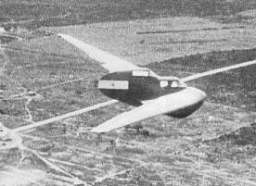
|
Above: Horten Ho 15a.
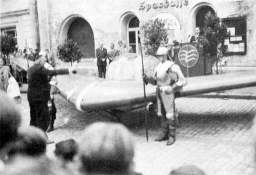
|
Above: Horten Ho 15c.
In the 1950, Reimar Horten was asked to build a cargo glider to transport oranges to Buenos Aires. In 1960, ten years after its conception, the I Ae 38 finally flew. It was demonstrated to a group of dignitaries on its first flight by test pilot Captain Ballado. Alas, ...
Afterwards, the aircraft was simply scrapped, and my employment with the Institute terminated.
His brother Walter stayed in Germany; he was able to develop a Ho 33 two-seater glider in 1951. A first version was scrapped, a second flew, but the commercial prospects for the aircraft were not good, as it was much too large and cumbersome for a two place ship. Plans to mass produce it were abandoned.
Reimar Horten died in 1994. Walter Horten was living in the city of Baden-Baden and died there on December 9, 1998.
Nicknamed “Colibri”, it was designed a small tailless sailplane for the Buenos Aires club “Condor” in 1950. The first one crashed on landing, and no further model was built.
Larger pictures of the Horten XVI here.
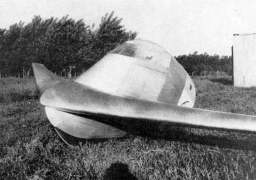
|
Above: Horten Ho 16.
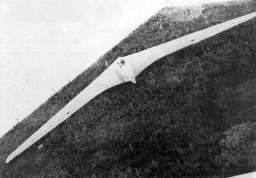
|
Above: Horten Ho 16, in flight in Argentina.
Photo Credits: Parts of the photos are from the book, “Nurflügel”, by Peter F. Selinger and Dr. Reimar Horten.
Several Horten models can be seen at the Deutsches Technikalmuseum (DTM) in Berlin, Germany. Four models (Ho IIL, Ho IIIf, Ho IIIh, Ho VI-V2 ) are preserved at The National Air and Space Museum ("The Smithsonian") in the US. A Ho IV is at the Planes of Fame Museum in Chino, California. The single Horten 33 belongs to the Wasserkuppe Museum.